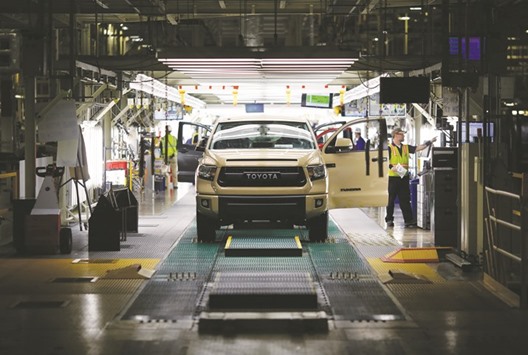US economic growth slowed in the first quarter although not as sharply as initially thought, as a surge in home building and steady inventory accumulation partially offset the impact of modest consumer spending and soft business investment.
Gross domestic product rose at a 0.8% annual rate as opposed to the 0.5% pace reported last month, the Commerce Department said yesterday in its second GDP estimate for the January-March period.
That was the weakest growth since the first quarter of 2015.
The upward revision reflected a smaller drag from trade than previously estimated.
The government also reported a rebound in after-tax corporate profits, which increased at a 0.6% rate in the first quarter after plunging at an 8.4% pace in the fourth quarter.
Income growth for the first quarter also was revised higher.
As a result, the economy grew at a much faster 2.2% rate when measured from the income side, after expanding at a 1.9% pace in the fourth quarter.
The economy has been hurt by a strong dollar and sluggish global demand, which have eroded export growth.
It has also been squeezed by lower oil prices, which have undercut profits of oilfield companies like Schlumberger and Halliburton, forcing them to slash spending on equipment.
Economists also believe the model used by the government to strip out seasonal patterns from data is not fully accomplishing its goal despite steps last year to address the problem.
Residual seasonality has plagued first-quarter GDP data, with growth underperforming in five of the last six years since the beginning of the economic recovery in 2009.
There are signs the economy regained momentum early in the second quarter, with retail sales, goods exports, industrial production, housing starts and home sales surging in April.
The Atlanta Federal Reserve is currently estimating second-quarter GDP rising at a 2.9% rate. But the ongoing high level of inventories poses a downside risk to that forecast.
Economists polled by Reuters had expected first-quarter GDP growth would be revised up to a 0.9% rate.
The economy grew at a 1.4% rate in the fourth quarter.
Prices for longer-dated US Treasuries briefly pared losses after the data, while the dollar fell against a basket of currencies.
US stock index futures were little changed.
Spending on residential construction increased at a 17.1% rate in the first quarter, the fastest pace since the fourth quarter of 2012.
It was previously reported to have increased at a rate of 14.8%. Residential construction added 0.56 percentage point to first-quarter GDP growth, up from the 0.49 percentage point reported last month.
Businesses accumulated $69.6bn worth of inventory, instead of the $60.9bn estimated last month.
Inventories cut two-tenths of a percentage point from GDP growth instead of the previously reported 0.33 percentage point.
There was no revision to consumer spending, which accounts for more than two-thirds of US
economic activity.
Spending increased at a pace of 1.9%, a slowdown from the fourth quarter’s 2.4% rate.
Households were frugal in the first quarter, cutting back on purchases of long-lasting manufactured goods like automobiles.
Income at the disposal of households after accounting for taxes and inflation was revised up to show it surging at a 4.0% rate in the first quarter instead of the previously reported 2.9%.
Savings were revised up to $782.6bn from $712.3bn.
Exports were not as weak as initially thought.
That, together with a decline in imports, produced a smaller trade deficit, which subtracted 0.21 percentage point from first-quarter GDP growth instead of the 0.34 percentage point reported last month.
A sustained plunge in energy sector investment undercut business spending.
Equipment spending tumbled at a steeper 9.0% rate, the fastest pace of decline since the second quarter of 2009.
It was previously reported to have dropped at a 8.6% rate.
Spending on equipment will likely remain weak in the second quarter, with a report on Thursday showing orders for manufactured capital goods excluding aircraft and defence declined in April for a third straight month.
Investment in nonresidential structures dropped at an 8.9% pace in the first quarter instead of the previously reported 10.7% rate.

A newly assembled Toyota Motor Corp Tacoma pickup truck moves through final inspection on the assembly line at the company’s manufacturing facility in San Antonio, Texas. Gross domestic product rose at a 0.8% annual rate as opposed to the 0.5% pace reported last month, the US Commerce Department said yesterday in its second GDP estimate for the January-March period.


